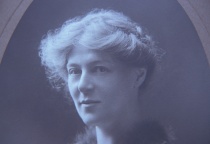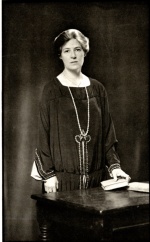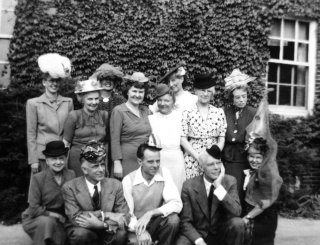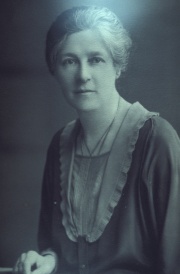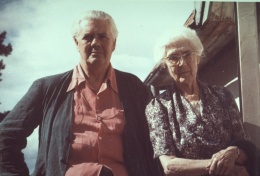Clara Codd: Difference between revisions
No edit summary |
No edit summary |
||
| Line 13: | Line 13: | ||
Even as a child, Clara questioned the meaning of life and felt moved into a search for "something." Religious training in the family consisted of attending the local Church of England parish churches, and memorizing passages of scripture. After Clara read a [[Spiritualism|spiritualist]] book called ''The Living Dead'', she was relieved of her childhood fears of hell, and embraced the concept of life after death.<ref>Clara Codd, ''So Rich a Life'' (Pretoria: Institute for Theosophical Publicity, 1956), 10.</ref> | Even as a child, Clara questioned the meaning of life and felt moved into a search for "something." Religious training in the family consisted of attending the local Church of England parish churches, and memorizing passages of scripture. After Clara read a [[Spiritualism|spiritualist]] book called ''The Living Dead'', she was relieved of her childhood fears of hell, and embraced the concept of life after death.<ref>Clara Codd, ''So Rich a Life'' (Pretoria: Institute for Theosophical Publicity, 1956), 10.</ref> | ||
While Clara was still a young woman, her father died, and the mother moved the family to Geneva, Switzerland where they could live more cheaply. Clara took on work wherever she could find it to help support the family. She "spent all the days teaching English, playing accompaniments, teaching music, and, for a short time, posing for artists as a model, never in the 'all-together' but as a costume model."<ref>Clara Codd, ''So Rich a Life'' (Pretoria: Institute for Theosophical Publicity, 1956), 11.</ref> Geneva had a cosmopolitan atmosphere, and Clara met people of many nationalities and social strata. She became proficient in speaking French. It was | While Clara was still a young woman, in January, 1901, her father died, and the mother moved the family to Geneva, Switzerland where they could live more cheaply. Clara took on work wherever she could find it to help support the family. She "spent all the days teaching English, playing accompaniments, teaching music, and, for a short time, posing for artists as a model, never in the 'all-together' but as a costume model."<ref>Clara Codd, ''So Rich a Life'' (Pretoria: Institute for Theosophical Publicity, 1956), 11.</ref> Geneva had a cosmopolitan atmosphere, and Clara met people of many nationalities and social strata. She became proficient in speaking French. | ||
== Introduction to Theosophy == | |||
It was in Geneva that the young woman first became acquainted with [[Theosophy]]: | |||
<blockquote> | <blockquote> | ||
Her first contact with Theosophy came through an Austrian neighbour, Madame von Pachten, who attended many concerts, meetings and lectures and often took the young Clara with her. One day she asked Clara if she would like to 'hear the theosophists'. The four theosophical lodges in Geneva at that time met in private homes. The one to which Clara was taken was that of the Russian Consul, Count Prozor. The second time she attended the lodge, Clara described the atmosphere of excitement as [[Henry Steel Olcott|Colonel Olcott]], a Principal [[Founders|Founder]] of the TS was due to speak. Clara described the Colonel's lecture as chatty and informal, simple and unassuming. He told of his life with [[Helena Petrovna Blavatsky|Madame Blavatsky]] and of the apparent [[Phenomena|marvels]] and miracles which took place in her presence. The highlight of the evening though, for Clara, was the Colonel's description of five [[Adepts]] whom he said he had personally known. Her life changed irrevocably from that moment on. She began to attend theosophical classes and subsequently joined the [[Theosophical Society (Adyar)|Theosophical Society]].<ref>Shirley Macpherson, "Clara Codd: A Woman of Character" ''Theosophy in Australia'' 64 (September, 2000), 74.</ref> | Her first contact with Theosophy came through an Austrian neighbour, Madame von Pachten, who attended many concerts, meetings and lectures and often took the young Clara with her. One day she asked Clara if she would like to 'hear the theosophists'. The four theosophical lodges in Geneva at that time met in private homes. The one to which Clara was taken was that of the Russian Consul, Count Prozor. The second time she attended the lodge, Clara described the atmosphere of excitement as [[Henry Steel Olcott|Colonel Olcott]], a Principal [[Founders|Founder]] of the TS was due to speak. Clara described the Colonel's lecture as chatty and informal, simple and unassuming. He told of his life with [[Helena Petrovna Blavatsky|Madame Blavatsky]] and of the apparent [[Phenomena|marvels]] and miracles which took place in her presence. The highlight of the evening though, for Clara, was the Colonel's description of five [[Adepts]] whom he said he had personally known. Her life changed irrevocably from that moment on. She began to attend theosophical classes and subsequently joined the [[Theosophical Society (Adyar)|Theosophical Society]].<ref>Shirley Macpherson, "Clara Codd: A Woman of Character" ''Theosophy in Australia'' 64 (September, 2000), 74.</ref> | ||
</blockquote> | </blockquote> | ||
Her mother was also interested in Theosophy, and eventually all but one of sisters became Theosophists. | She joined the French Section of the Theosophical Society at age 27, on December 16, 1903,<ref>The International Theosophical Year Book 1938 (Adyar, Madras, India: Theosophical Publishing House, 1938): 173.</ref> and attended a class for beginners. After a few more months in Switzerland, the family moved back to England, to Bath, in Somerset. Clara took a job as a governess in Ireland for some months, and on returning to Bath went to a meeting of the local Theosophical Society lodge. The lecturer was Bernard Old, a younger brother of [[Walter Gorn Old]]. The lodge president took Clara north to visit the Harrogate lodge, to meet [[Annie Besant]]. Her mother was also interested in Theosophy, and eventually all but one of sisters became Theosophists. The family hosted visiting Theosophical lecturers such as A. W. Orange, who assisted Clara when she prepared to give her first talk to the lodge.<ref>Clara Codd, ''So Rich a Life'' (Pretoria: Institute for Theosophical Publicity, 1956), 10.</ref> | ||
[[File:Clara Codd 6.jpg|150px|thumb|Clara Codd]] | |||
== Feminist activities == | == Feminist activities == | ||
During the years in Bath, Clara became an ardent Socialist, with strong sense for freedom and justice. She was asked to help steward meetings when suffragettes Christabel Pankhurst and Annie Kenney came to Bath. Clara offered to assist Annie, who headed the Bristol district of the Women's Social and Political Union. The women held weekly meetings to answer the questions of the public. They often gave lectures from the back of a lorry, distributed literature from a rented shop, and disrupted speeches by politicians like David Lloyd George. The work became increasingly dangerous. When Christabel Pankhurst planned a raid on the well-guarded House of Commons, Clara went to London to participate. She, the Parkhursts, and others were arrested and sent to Holloway Gaol for a month. <ref>Clara Codd, ''So Rich a Life'' (Pretoria: Institute for Theosophical Publicity, 1956), 46-79.</ref> After her release, Clara was offered a position as an organizer for the Union, but chose instead to work for Theosophy. | |||
== Theosophical lecturer in England == | |||
== | In 1906 Miss Codd was appointed to be the first national lecturer for the English Section, supported by an annual salary of £50 provided by a wealthy member from Birmingham. At first she was shy and felt ill-prepared, but with experience she gained confidence. When funds ran out, Clara was made Librarian at the headquarters of the Theosophical Society in England, which gave her the opportunity to become more familiar with Theosophical literature. She became friendly with the family of Lancashire businessman Joseph Bibby, who edited ''Bibby's Annual''. He proposed to send Clara for a two-year course at the Theosophical Society headquarters in Adyar, Madras, India. with encouragement of Annie Besant, Clara embarked for India.<ref>Clara Codd, ''So Rich a Life'' (Pretoria: Institute for Theosophical Publicity, 1956), 88-106.</ref> | ||
< | |||
== Study in India == | == Study in India == | ||
Revision as of 03:40, 12 July 2016
ARTICLE UNDER CONSTRUCTION
ARTICLE UNDER CONSTRUCTION
Clara Codd was an English Theosophist known for her work as a feminist, lecturer, teacher, and writer. She served as General Secretary of both the Australian and South African Sections of the Theosophical Society based in Adyar, Chennai, India. During a Theosophical career of nearly 70 years, she traveled to five continents. Her autobiography is rightfully called So Rich a Life. Theosophists who counted her as major influences in their lives included Joy Mills, John Algeo, James S. Perkins, Eleanor Stakesby-Lewis, Shirley Macpherson, and many others.
Early life and education
Clara Margaret Codd was born October 10, 1876 at Barnstaple, Devon, England.[1] She was the oldest of ten daughters. Her father, Henry L. Codd, was an Inspector of Schools for Cornwall and part of Devon, but had previously spent some years in a nautical career. His wife Clara V. Codd was a half-Italian beauty who with Henry was active in North Devon hunting society. The daughters were educated by a series of governesses. Clara was a shy and sensitive child and read extensively from her father's library; the works of Sir Walter Scott and Thomas Carlyle were especially meaningful to her. Mrs. Codd took her to plays and concerts, and Clara learned to sing and play the violin in a local orchestra. She became a proficient pianist and loved to accompany singers throughout her life.[2]
Even as a child, Clara questioned the meaning of life and felt moved into a search for "something." Religious training in the family consisted of attending the local Church of England parish churches, and memorizing passages of scripture. After Clara read a spiritualist book called The Living Dead, she was relieved of her childhood fears of hell, and embraced the concept of life after death.[3]
While Clara was still a young woman, in January, 1901, her father died, and the mother moved the family to Geneva, Switzerland where they could live more cheaply. Clara took on work wherever she could find it to help support the family. She "spent all the days teaching English, playing accompaniments, teaching music, and, for a short time, posing for artists as a model, never in the 'all-together' but as a costume model."[4] Geneva had a cosmopolitan atmosphere, and Clara met people of many nationalities and social strata. She became proficient in speaking French.
Introduction to Theosophy
It was in Geneva that the young woman first became acquainted with Theosophy:
Her first contact with Theosophy came through an Austrian neighbour, Madame von Pachten, who attended many concerts, meetings and lectures and often took the young Clara with her. One day she asked Clara if she would like to 'hear the theosophists'. The four theosophical lodges in Geneva at that time met in private homes. The one to which Clara was taken was that of the Russian Consul, Count Prozor. The second time she attended the lodge, Clara described the atmosphere of excitement as Colonel Olcott, a Principal Founder of the TS was due to speak. Clara described the Colonel's lecture as chatty and informal, simple and unassuming. He told of his life with Madame Blavatsky and of the apparent marvels and miracles which took place in her presence. The highlight of the evening though, for Clara, was the Colonel's description of five Adepts whom he said he had personally known. Her life changed irrevocably from that moment on. She began to attend theosophical classes and subsequently joined the Theosophical Society.[5]
She joined the French Section of the Theosophical Society at age 27, on December 16, 1903,[6] and attended a class for beginners. After a few more months in Switzerland, the family moved back to England, to Bath, in Somerset. Clara took a job as a governess in Ireland for some months, and on returning to Bath went to a meeting of the local Theosophical Society lodge. The lecturer was Bernard Old, a younger brother of Walter Gorn Old. The lodge president took Clara north to visit the Harrogate lodge, to meet Annie Besant. Her mother was also interested in Theosophy, and eventually all but one of sisters became Theosophists. The family hosted visiting Theosophical lecturers such as A. W. Orange, who assisted Clara when she prepared to give her first talk to the lodge.[7]
Feminist activities
During the years in Bath, Clara became an ardent Socialist, with strong sense for freedom and justice. She was asked to help steward meetings when suffragettes Christabel Pankhurst and Annie Kenney came to Bath. Clara offered to assist Annie, who headed the Bristol district of the Women's Social and Political Union. The women held weekly meetings to answer the questions of the public. They often gave lectures from the back of a lorry, distributed literature from a rented shop, and disrupted speeches by politicians like David Lloyd George. The work became increasingly dangerous. When Christabel Pankhurst planned a raid on the well-guarded House of Commons, Clara went to London to participate. She, the Parkhursts, and others were arrested and sent to Holloway Gaol for a month. [8] After her release, Clara was offered a position as an organizer for the Union, but chose instead to work for Theosophy.
Theosophical lecturer in England
In 1906 Miss Codd was appointed to be the first national lecturer for the English Section, supported by an annual salary of £50 provided by a wealthy member from Birmingham. At first she was shy and felt ill-prepared, but with experience she gained confidence. When funds ran out, Clara was made Librarian at the headquarters of the Theosophical Society in England, which gave her the opportunity to become more familiar with Theosophical literature. She became friendly with the family of Lancashire businessman Joseph Bibby, who edited Bibby's Annual. He proposed to send Clara for a two-year course at the Theosophical Society headquarters in Adyar, Madras, India. with encouragement of Annie Besant, Clara embarked for India.[9]
Study in India
Theosophical activities in the United States
In 1929, the young Miss Codd toured the United States, visiting thirteen Midwestern cities in two months. While in Iowa, she spoke on "Reincarnation" "to about 500 young people in a commercial school at Des Moines. These young people had formerly been addressed by Mr. Hoover [Herbert Hoover - later the U. S. president] ... and by Billy Sunday [a megastar evangelist]."[10] During 1929 and 1930, while living at the headquarters of the American Section, she wrote several books that were published by Theosophical Press.
Involvement in Golden Link
Miss Codd was the International Chief Link in the Golden Chain of Love, a children's movement that came to be associated with the Theosophical Order of Service. Her sister Dorothy Mary Codd was Chief Link for Europe.[11]
Years in South Africa
From February 2, 1938 to May 21, 1946, Miss Codd lived in the Union of South Africa, and became a citizen of that country. She served as National President (General Secretary) of the Section, and received a small pension after her term there.[12] In January of 1945, her term ended, she wrote to Sidney Cook at the Theosophical Society in America:
Mr. Kruisheer is a splendid G.S. He is such a good organiser. I shall never be a Gen. Sec. agoin. I do not think that that is the best thing I can do. I am not an administrator. I just fill in a gap. For some time now I have had a pet idea. Tell me if you think it is feasible. I would like to go round the world once more before I pass over and say goodbye to all the dear people I love so well. This Xmas I have heard again from so many in the U.S.A...Could you have me for lecturing for a year? You need not give me any salary as now I am the proud possessor of a pension. And then I could go on to N.Z. and Australia and finally settle somewhere.
I would like to spend my last days in inspiring and teaching the Masters young workers somewhere.[13]
Years in Australia
Miss Codd had two long visits to Australia. On the first occasion she was asked by Mr. Jinarājadāsa to assist in rebuilding the Australian Section. On October 28, 1923, 600 Sydney members left to form the Independent Theosophical Society under the leadership of T. H. Martyn................
Her second stay in Australia lasted for four years, 1934-1937. She toured the entire country, staying at each city for several weeks, "giving public lectures on the full range of basic Theosophy" as well as members' meetings.[14] A member reported,
At each lecture Clara filled the Adelaide Lodge to overflowing and we as young Theosophists sat on the windowsills at the back of the hall. She was adept at answering questions and always gave a practical, down to earth remedy for any problem.
While she was in Australia trouble had been brewing between the Radio Station 2GB and the General Secretary who, at that time, was finding the situation difficult to handle. Clara was asked if she would take over as General Secretary and agreed, holding that position for two years in 1934 and 1935... she used to broadcast a short address on a theosophical subject every afternoon from 2GB.[15]
Miss Codd was unaccustomed to administrative work, but she was an effective leader for the TS in Australia. Since the organization was heavily in debt following the worldwide economic trauma of the Great Depression, she cut her own salary in half and eliminated other staff positions. By performing all the office tasks herself, she succeeded in paying all debts in six month's time. The national magazine was revived. She wrote,
I was very happy as General Secretary of Australia. I could not lecture so much, but it brought me in touch with the organisational side of our work and into touch with the International President who was then Dr. Arundale, and such experience has stood me in very good stead.[16]
Later years
The Fifth World Congress of the Theosophical Society, Adyar, in Salzburg, Austria, was the last public appearance of Miss Codd. According to Joy Mills,
"No one who attended that Congress at Salzburg will ever forget the lecture 'our beloved Clara' gave there; it was, she said, her 'farewell' lecture, but although she was in her 90th year, she spoke with all the vigor and dynamic vibrancy of the eternally young. The standing ovation that followed her talk was the spontaneous tribute of the members to the gallant soldier who never swerved from the vow she had taken, on entering the Society, to use every talent and capacity in the service of humanity.[17]
Her final years were spent at Ways End, Camberley, near Tekels Park in England,[18] supported by a small pension provided by the Theosophical Society Sections in the United States, Australia, South Africa, and England. She died peacefully on April 3, 1971. Her younger sisters Dorothy (Dolly), Isabel, and Leilah received many expressions of condolence and support from Theosophists around the world.
The entire October, 1976 issue of The Theosophist was devoted to articles about her.
Letters
Miss Codd conducted a massive correspondence with people all over the world. She established a "correspondence group," whose members received a bi-monthly duplicated letter, from 1945 until 1968. Some examples of the letters are available in Clara Codd Letters.
Writings
Clara Codd made significant contributions to Theosophical literature. The Union Index of Theosophical Periodicals lists 466 articles by or about Clara Codd. That number includes dozens of articles that she wrote or edited for the News and Notes of the Theosophical Society in Australia during 1934-1936. She wrote a regular column called "The Inner Life" in the journals of the American Section: The Theosophical Messenger from 1930-1932, and The American Theosophist from 1932-1940.
Miss Codd enjoyed theater, and wrote some plays and skits for Theosophist audiences. For example, while at the Olcott campus of the American Section, her play "The Pilgrimage of the Soul" was presented on New Year's Eve. Viewers said,
The play ... portrayed in symbolic fashion and pageantry the descent of the ego into the lower worlds, his long journey and return. An improvised stage was set up at the fire-place end of the library. Members of the Staff made up the cast and were dressed in simple costumes. They read quotations chosen by Miss Codd to fit the action and mood of her play. And with interludes of piano music accompanying the movement of the play, at atmosphere perhaps something like that created during the presentation of the mystery plays in Greece stirred and was felt by all."[19]
She also published many books and booklets, some of which are transcribed lectures:
- Ageless Wisdom of Life. Adyar, Madras, India, 1957 [2nd edition], available at Hathitrust. The 4th edition, published by the Theosophical Publishing House in Wheaton, IL in 1967, is available at Hathitrust. Translated into Russian by Dagmara Reinke and published as Taina Zhizni: i kak teosofiia otvechaet na nikh in Boston by ALBA, 1963. In 1959 a Finnish translation by Sirkka Simonen was published as Elämän ajaton viisaus by the Kalevala Lodge in Helsinki. Another Finnish version was translated by Eino Vuorinen.
- The Consecrated Life.
- The Creative Force. Also published in Dutch as De scheppende kracht: Amsterdam : Theosofische Vereniging, Ned. Afd, 1960.
- The Eternal Wisdom of Life. Also published in Spanish as La eternal sabiduria de la vida: México : B. Costa-Amic, 1968. Translated by Ingeniero Salvador Tayabas y Sonia Pérez Vera. Reissued México, México: Orion, 1981.
- Introduction to Patanjali's Yoga. Adyar, Madras, India: Theosophical Publishing House, 1966. 164 pages.
- The Key to Theosophy. Adyar, Madras, India: Theosophical Publishing House, 1953. 262 pages. This is the "1st simplified Adyar edition" by Clara Codd of the work by H. P. Blavatsky.
- On Lecturing and Lecture Organization. London: Theosophical Publishing House, 1922. 64 pages.
- Letter to Aspirants. A Spanish edition called Carta a los aspirantes was published in 2015.
- Looking Forward: The Coming faith and the Coming Social Order. Edinburgh: Orpheus Publishing House, 1918. 71 pages.
- Masters and Disciples: A Guide to Study. London, 1928.
- Meditation: Its Practice and Results. Wheaton, IL: Theosophical Press, 1930, and several later editions. 92 pages. Available at Hathitrust. A French edition was published as La méditation: sa pratique et ses buts - Paris: Adyar Editions 1931.
- The Mystery of Life and How Theosophy Solves It. London: Theosophical Society. Theosophical Society in England and Wales, 1963. Wheaton, IL: Theosophical Publishing House, 1972. Revised edition London: Theosophical Publishing House, 2001. Slovenian translation by Maja Lorbek and Jelka Godec under the title Skrivnost zivljenja kot jo razkriva teozofija, published by Izola: Samozal M. L. Pigraf, 2002. Also published in Dutch as Het levensmysterie, number 7 in the series Theosofische bibliotheek; n.s., 7: Amsterdam : Theosofische Vereniging Ned. Afd, 1950.
- The Other Side of Death. London: Theosophical Society, 1900s. 16 pages. Theosophy series, no. 12. French version, L'Au-delà de la mort , was published in 1929 in Paris by Société théosophique de France.
- Poems. 1964. Poetry written by Clara Codd and her sister Dorothy Codd.
- Reincarnation: An Answer to Life's Problems. London: Theosophical Society, nd. 16 pages. Number 12 or 13 in Theosophy series of pamphlets.
- The Riddle of Life and How Theosophy Answers It. Johannesburg: Theosophical Service Group, 1940. 28 pages. Notation of "S Pam 212."
- The Secret of Sin and Suffering. Wheaton, IL: Theosophical Press, 1931. 15 pages.
- So Rich a Life. Pretoria: Institute for Theosophical Publicity, 1951. 431 pages. Autobiography.
- Technique of the Spiritual Life. Adyar, India: Theosophical Publishing House, 1958. 2nd edition, 1963. Translated into Finnish by Pirkko Carpelan as Ohjeita henkisen tien kulkijalle: [Hki] : Elonpyörä, (Painoseppä), 1977. 125 pages. Spanish translation by Walter Ballesteros was published in 1963 by Sociedad Teosófica as Técnica de la vida espiritual.
- The Theosophical Worker. Two articles from the August and September issues of The Theosophist were translated into Dutch and published as De theosofische werker in 1958. "The Worker in the World" by Clara Codd was followed by Hugh Shearman's "The Task of the Worker."
- Theosophy and Christianity. London : Theosophical Society, nd. 16 pages. Number 23 in series of "Penny booklets."
- Theosophy as the Masters See It: Being an account of the Theosophical Society and its work as outlined in the "Letters from the masters of the wisdom." Adyar, Madras, India: Theosophical Publishing House, 1953. 369 pages.
- Theosophy for Little Children. Wheaton, IL: Theosophical Press, 1930. 45 pages.
- Theosophy for Very Little Children. Adyar, Madras, India: Theosophical Publishing House, 1916. Also published in Dutch: Amsterdam: Theosofische Vereenigings Uitgevers-Maatschappij, 1925.
- There Is No Death: A Message of Comfort. Auckland, N.Z.: New Zealand Section of the Theosophical Society, 1959. 22 pages.
- Thought, the Creator. London: Theosophical Society, 1927. 16 pages. Theosophy series, number 13.
- Trust Yourself to Life. Wheaton, IL: Theosophical Publishing House, 1968 and 1975. 116 pages. A Quest Books miniature.
- The Understanding Life: Three Lectures. Wheaton, Illinois: Theosophical Press, 1929. Ojai, CA : Theosophical Book Association for the Blind, 1969. Braille. Three lectures.
- The Way of the Disciple. 2nd edition. Chennai, India: Theosophical Publishing House, 1964 and 2000. 287 pages. Contents: 1. The brotherhood of the perfected men -- 2. Discipleship -- 3. The restoration of the mysteries. Also published in Dutch as Het pad van de leerling - Amsterdam : Theosofische Vereniging, 1970.
Lectures
Miss Codd did not feel she was a trained lecturer. She wrote, "I do not think I lecture. I just talk. Of course I have realized that there some moments when one is talking when the sublimity of the subject lifts one up."[20] Audiences responded to her humanity and her inspiration, and she was much in demand across five continents.
"She just chatted away as if we were all sitting around the fireside. No other speaker I know of has ever achieved such intimacy and closeness with those who listened to her. Each felt as it receiving a very personal message. She always stood on the platform a very slim and erect figure in a long black dress.[21]
She would speak with a few note cards in her card, but rarely referred to them. Many of Clara Codd's lectures were recorded or transcribed.
Audio recordings
- Arcane Schools of Past and Future by Clara Codd
- Life on the Other Side of Death by Clara Codd
- Wings of the Soul by Clara Codd
Additional recordings are available through the Henry S. Olcott Memorial Library and Quest Books.
Transcribed or published lectures
Many of Miss Codd's lectures were published as booklets, or collected in books like The Understanding Life.
- Annie Besant and C. W. Leadbeater, As I Knew Them
- Discipleship in the New Age
- The New World Order
- Our Leaders As I Knew Them
- Saintship in the Theosophical Society
- The Way of Initiation
Additional resources
- Clara Codd: A Personal Recollection by John Algeo
- A Tribute to Clara Codd by Leatrice Kreeger
Notes
- ↑ Application to Extend Time of Temporary Stay. US Immigration and Naturalization Service. December 23, 1946. James S. Perkins Papers. Records Series 08.06. Theosophical Society in America Archives.
- ↑ Clara Codd, So Rich a Life (Pretoria: Institute for Theosophical Publicity, 1956), 5-8.
- ↑ Clara Codd, So Rich a Life (Pretoria: Institute for Theosophical Publicity, 1956), 10.
- ↑ Clara Codd, So Rich a Life (Pretoria: Institute for Theosophical Publicity, 1956), 11.
- ↑ Shirley Macpherson, "Clara Codd: A Woman of Character" Theosophy in Australia 64 (September, 2000), 74.
- ↑ The International Theosophical Year Book 1938 (Adyar, Madras, India: Theosophical Publishing House, 1938): 173.
- ↑ Clara Codd, So Rich a Life (Pretoria: Institute for Theosophical Publicity, 1956), 10.
- ↑ Clara Codd, So Rich a Life (Pretoria: Institute for Theosophical Publicity, 1956), 46-79.
- ↑ Clara Codd, So Rich a Life (Pretoria: Institute for Theosophical Publicity, 1956), 88-106.
- ↑ "Chicago Lectures" The American Theosophist 17.10 (October 1929), 230.
- ↑ The International Theosophical Year Book 1938 (Adyar, Madras, India: Theosophical Publishing House, 1938): 138-139, 173-174.
- ↑ Application to Extend Time of Temporary Stay. US Immigration and Naturalization Service. December 23, 1946. James S. Perkins Papers. Records Series 08.06. Theosophical Society in America Archives.
- ↑ Letter from Clara Codd to Sidney Cook. January 22, 1945. Sidney A. Cook Papers. Records Series 08.05. Theosophical Society in America Archives.
- ↑ Edriss Noall, "Memories of Clara Codd" The Theosophist 98.10 (October, 1976), 10.
- ↑ Shirley Macpherson, "Clara Codd: A Woman of Character" Theosophy in Australia 64 (September, 2000), 75-76.
- ↑ Clara Codd, So Rich a Life (Pretoria: Institute for Theosophical Publicity, 1956), 386-387.
- ↑ Joy Mills, "'That Kind and Gracious Other Side of Life'" The American Theosophist 59.6 (June, 1971), 7.
- ↑ Dorothy and Isabel Codd, "Notices: Clara Codd" Theosophical Journal 12.5 (September-October, 1971), 23.
- ↑ "Miss Codd's Play Given a Reading" The American Theosophist 37.2 (February, 1949), 46.
- ↑ Assistant Editor, "Clara Codd's Letters" The Theosophist 98.10 (October, 1976), 29.
- ↑ Eleanor Stakesby-Lewis, '"Miss Clara M. Codd" Theosophical Journal12.4 (July-August, 1971), 23.

